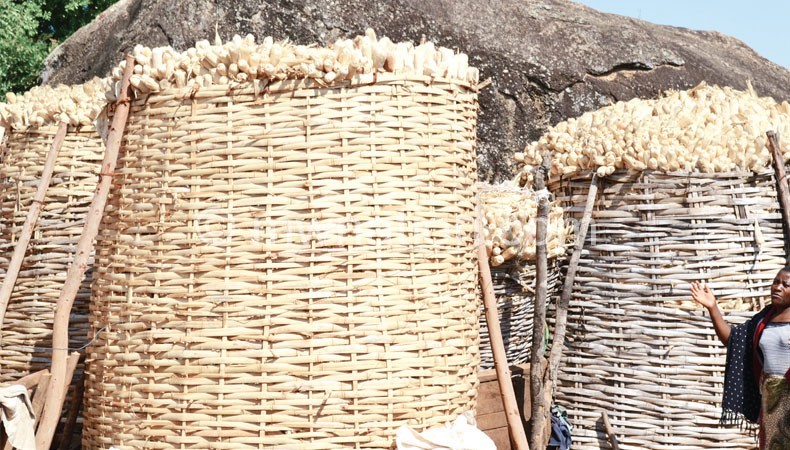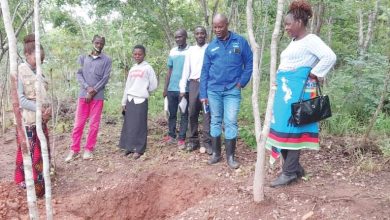Much ado about maize
The challenge of malnutrition confirms that Malawians cannot live by maize alone, Mzuzu Bureau Supervisor JAMES CHAVULA writes.
Having twins could be likened to killing two birds with one stone, but Mary Banda calls it a tough test.
“My husband and I had no idea what it entails, but we got a rude awakening when the boys started experiencing weight loss and swollen feet,” says the mother of four in Kapokonyoka Village in Hehleni, Mzimba South West.
She recalls health surveillance assistant Jonathan Nyasulu asking her to hurry the twins with acute malnutrition to a clinic at Hehleni where a clinical officer further referred her to Katete Mission Hospital for nutritional rehabilitation as “a matter of life or death”.
Not that they were being underfed, she says. With thick maize fields surrounding their thatched hut, Banda narrated how she kept giving the children platefuls of maize-flour porridge—even at night.
“After six months of breastfeeding, I started giving them porridge morning, noon and evening. Even at night. Yet the children got so malnourished that even their hair looked weak,” she recalled the chapter she struggles to forget.
Just like that, the twins became pathetic human faces of malnutrition, which affects 47 in 100 under-five children, in the country that markets itself as an agricultural economy with 80 percent of its workforce being farmers.
Not anymore
The children have grown into bouncy two year-olds, thanks to Thanzi porridge made out of maize flour mixed with a diversity of nutrient-rich foods—including beans, groundnuts, vegetables, fruits and milk.
The state of the children persuaded her to join a women group trained by Feed the Children, a non-governmental organisation which works with a cadre of community nutrition promoters to scale up coverage of locally appropriate solutions to malnutrition.
Any lessons learnt? Plenty, said Banda.
“A person cannot live by maize alone,” she said.
She discredits the widespread mentality which seems to confine infants to maize porridge and adults to its thicker derivative called nsima.
She explains: “Many children are not growing properly because parents do not know food groups or how to prepare six-in-one meals. They don’t know nutritious food does not require money. It can even be made from locally available foods people take for granted.”
In this respect, the rural woman is not your ordinary Malawian anymore.
When Malawians mention food security, they are not always talking about diverse diets. Often times, they are referring to maize. Such is the obsession with maize that the ruling Democratic Progressive Party (DPP) emblem comprises not one cob or two—but four. The mania with maize on party badges is a typical feature of what The Lamp magazine once termed “politics of food’.
For the past decade, the thin line between politics and food sufficiency has been best exemplified by huge subsidies of farm inputs that largely target maize cropping for subsistence purposes. In the 2015/16 national budget, the Farm Input Subsidy Programme (Fisp) got nearly K40 billion for 150 000 metric tons of fertiliser and seed targeting 1.5 million farming families.
Shocking tragedy
Almost K20 billion less than last year’s expenditure, the initiative mirrors the huge cost of uplifting maize production as the country struggles for food sufficiency.
Failing to look further than maize could be the reason nearly half of the Malawian population is stunting and undernourished, both government officials and independent experts say.
In May, Principal Secretary for the Ministry of Agriculture, Irrigation and Water Development Erica Maganga confirmed: “The country is experiencing challenges in overcoming malnutrition despite several efforts to improve food sufficiency.
“The country has achieved Millennium Development Goal [MDG] 4 on eliminating hunger, but malnutrition levels remain unacceptably high and the results are costly.”
In an interview at Euthini, Mzimba, during the launch of a Farmers Union of Malawi (FUM) initiative to improve nutrition in 13 districts, Maganga spelled out some of the harsh effects of ill nutrition: stunting, poor mental growth, reduced life expectancy and increased proneness to avoidable diseases that drain the country’s healthcare budget currently strained by effects of HIV and Aids infections.
However, stunting remains the most prevalent signal of malnutrition.
In 2009, the national Demographic Health Survey (DHS) indicated 47 out of 100 Malawians are stunted. The State-sponsored study shows Nkhata Bay is the worst hit with nearly 49 out of 100 people stunting.
The Department of Nutrition and HIV and Aids (DNHA) in the Ministry of Health partly symbolises political will to put anti-malnutrition efforts at the heart of the country’s development agenda.
DNHA deputy director Blessings Muwalo says it is “a shocking tragedy” for an agricultural nation to be among countries with the highest levels of stunting globally.
“The stunting of half of the population is shocking. The tragedy is that stunting does not only stunt one’s body and their chances in life, but also the way they think. How can we reduce poverty with stunted minds?” Muwalo quips.
But the gravity of stunting is a global concern. In 2010, the United Nations (UN) General Assembly resolved to enhance nutrition for all, a global agenda the country adopted when the then first lady Callista Mutharika launched the Scaling Up Nutrition (SUN) initiative in Lilongwe on July 28 2011.
The country’s approach broadly focuses on achieving improved food security, diverse diets and healthy children, especially during pregnancy and the first two years of life.
Research shows optimal nutrition during the first two years of life can have significant positive impact not only on children’s health but throughout a person’s life as well as the social and economic development of a nation, reads a factsheet by UN’s Food and Agricultural Organisation (FAO).
However, Muwalo clarifies: “Focusing on women and babies is just the beginning; malnutrition transcends age limits.
“If we choose a national football team, the majority of players are all short. Do they do well? No, they are perpetual losers. Our stars are stunted and the country is spending million of kwacha on a game we cannot win because of nutritional challenges.”
Memories are still fresh how Didier Drogba, Solomon Kalou, Yaya Toure and other Elephants of Ivory Coast stood head and shoulder above the “stunted Flames” at Kamuzu Stadium in 2012.
Beyond nsima
FAO envisions strengthening agriculture and food-based solutions to hunger and malnutrition. To lessen chronic setback, the UN agency is working with locals and departments of agriculture, nutrition, water and sanitation and health to support national efforts to improve food security, diets and children health in Kasungu and Mzimba.
Its nutrition officer Stacia Nordin pointed out the need for increased awareness among policymakers and the public of the benefits of food and dietary diversification.
In an interview, Nordin said: “There is need to raise awareness among policymakers and the public of the benefits of food and dietary diversification. Communities must be empowered to grow, purchase and prepare nutrient-rich foods, including legumes, vegetables, fruits, groundnuts and animal-source foods.”
The call for maize-based diets to be complemented with a variety of other foods is not a new song—except it comes loud and clear when floods, droughts and other disasters hit. Sadly, the “food diversity” chorus is often restricted to fast-growing, drought-resilient energy-giving crops, especially cassava and sweet potatoes.
In Nordin’s words, the narrow diversification efforts boil down to one thing: nsima.
“Nsima is just nsima whether it is made of maize or cassava flour,” she explains. “Nsima is the main form of food and the main source of calories. Yet calories alone are not more sufficient to prevent malnutrition and ensure good health throughout life. It cannot supply all essential amino and fatty acids, the necessary building blocks for body growth.”
Deputy director of nutrition in the Ministry of Agriculture, Dr Mzondwase Mgomezulu, agrees that inadequate dietary options are a major drawback to the health of the nation.
“The country cannot continue shunning other foods in preference for nsima. Besides investing in nutrition training of agricultural and health extension staff, we need to empower communities to stop over-depending on maize and cassava. We need to embrace a diversity of foodstuffs with nutrients,” says Mgomezulu.
She supports increasing calls for community nutrition assistants to facilitate uptake of nutrient-rich local foods, dietary counselling, group cooking sessions and social mobilisation.
Additionally, she says, nutrition should be taught in school to ensure every Malawian grows up aware of the six food groups, especially their composition, significance and how to prepare them.
Prevention vs cure
The cost of managing and treatment of malnutrition cases is huge, the experts agree.
“We feel the impact in the health sector. We are spending money that we need not spend if we prevent malnutrition,” says Tapiwa Nguluwe, the principal nutritionist in the Ministry of Health.
According to Nguluwe, nsima-dominated diets are not only a risk factor for malnutrition in children but also obesity, diabetes and other non-communicable diseases (NCDs) in adults.
The preventable cost of malnutrition constitute a multibillion kwacha wastage, most of it accounting for procurement of ready-to-use therapeutic food [RTF] for overly malnourished children and drugs for NCDs that result in death and disability of thousands of Malawians every year.
“Preventing malnutrition is essentially the duty of the Ministry of Agriculture, but the impact spreads to the healthcare system and the nation pays a big price if we don’t prevent it. Management of acute malnutrition and NCDs is much more expensive than promoting healthy eating habits.”
She cited Hehleni and Katete among some areas where the saying “prevention is better cure” has proved true, saying: “where the quest for food security, improved diets and health children have been effective, cases of malnutrition are almost non-existent.” n





